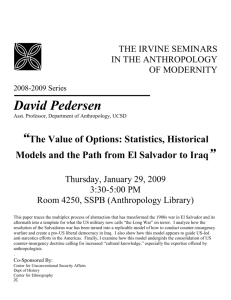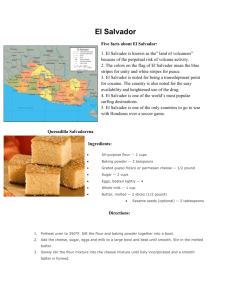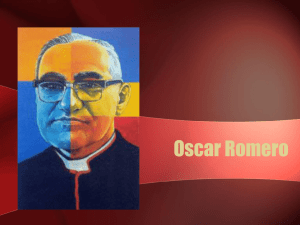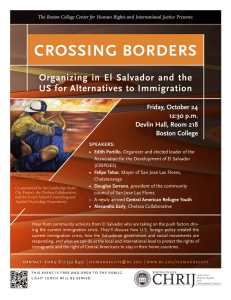ASLS Nicaragua goes to El Salvador The Politics Corner Xavier University 2010
advertisement
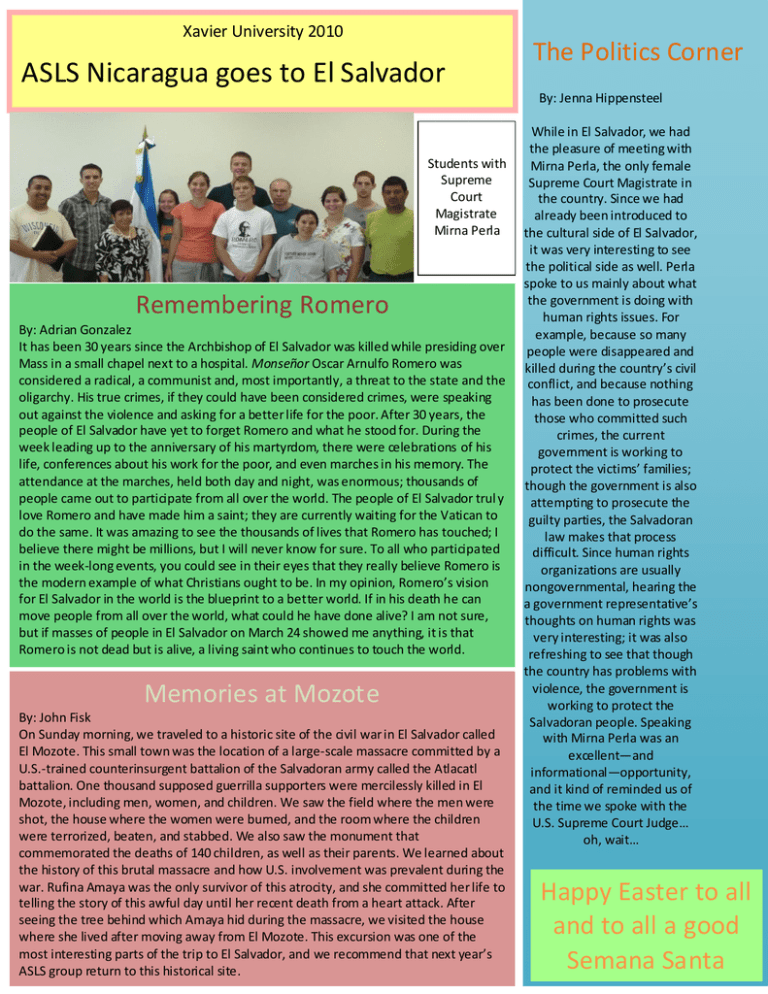
Xavier University 2010 ASLS Nicaragua goes to El Salvador The Politics Corner By: Jenna Hippensteel Students with Supreme Court Magistrate Mirna Perla Remembering Romero By: Adrian Gonzalez It has been 30 years since the Archbishop of El Salvador was killed while presiding over Mass in a small chapel next to a hospital. Monseñor Oscar Arnulfo Romero was considered a radical, a communist and, most importantly, a threat to the state and the oligarchy. His true crimes, if they could have been considered crimes, were speaking out against the violence and asking for a better life for the poor. After 30 years, the people of El Salvador have yet to forget Romero and what he stood for. During the week leading up to the anniversary of his martyrdom, there were celebrations of his life, conferences about his work for the poor, and even marches in his memory. The attendance at the marches, held both day and night, was enormous; thousands of people came out to participate from all over the world. The people of El Salvador trul y love Romero and have made him a saint; they are currently waiting for the Vatican to do the same. It was amazing to see the thousands of lives that Romero has touched; I believe there might be millions, but I will never know for sure. To all who participated in the week-long events, you could see in their eyes that they really believe Romero is the modern example of what Christians ought to be. In my opinion, Romero’s vision for El Salvador in the world is the blueprint to a better world. If in his death he can move people from all over the world, what could he have done alive? I am not sure, but if masses of people in El Salvador on March 24 showed me anything, it is that Romero is not dead but is alive, a living saint who continues to touch the world. Memories at Mozote By: John Fisk On Sunday morning, we traveled to a historic site of the civil war in El Salvador called El Mozote. This small town was the location of a large-scale massacre committed by a U.S.-trained counterinsurgent battalion of the Salvadoran army called the Atlacatl battalion. One thousand supposed guerrilla supporters were mercilessly killed in El Mozote, including men, women, and children. We saw the field where the men were shot, the house where the women were burned, and the room where the children were terrorized, beaten, and stabbed. We also saw the monument that commemorated the deaths of 140 children, as well as their parents. We learned about the history of this brutal massacre and how U.S. involvement was prevalent during the war. Rufina Amaya was the only survivor of this atrocity, and she committed her life to telling the story of this awful day until her recent death from a heart attack. After seeing the tree behind which Amaya hid during the massacre, we visited the house where she lived after moving away from El Mozote. This excursion was one of the most interesting parts of the trip to El Salvador, and we recommend that next year’s ASLS group return to this historical site. While in El Salvador, we had the pleasure of meeting with Mirna Perla, the only female Supreme Court Magistrate in the country. Since we had already been introduced to the cultural side of El Salvador, it was very interesting to see the political side as well. Perla spoke to us mainly about what the government is doing with human rights issues. For example, because so many people were disappeared and killed during the country’s civil conflict, and because nothing has been done to prosecute those who committed such crimes, the current government is working to protect the victims’ families; though the government is also attempting to prosecute the guilty parties, the Salvadoran law makes that process difficult. Since human rights organizations are usually nongovernmental, hearing the a government representative’s thoughts on human rights was very interesting; it was also refreshing to see that though the country has problems with violence, the government is working to protect the Salvadoran people. Speaking with Mirna Perla was an excellent—and informational—opportunity, and it kind of reminded us of the time we spoke with the U.S. Supreme Court Judge… oh, wait… Happy Easter to all and to all a good Semana Santa Gangs and Gringos By: Ryan Lavalley Gangs were and are highly active in the cities of El Salvador, and we had the unique opportunity to speak with a small group of young gang members. We sat in a house smaller than those in which we live in Nicaragua, on the ground for a lack of chairs. We listened to the stories of young teens, between the ages 12 and 24, trying to support a community and often times a family. One 14-year-old girl already had a child while at least half the other jovenes there were parents as well. The gangs I had seen on TV and in the movies were tattooed, over-muscular, pierced brutes who were ready to kill any person who blinked the wrong eyelash, but those who we met in San Salvador were nothing of the sort. These were humans: humans searching for acceptance and a community that would stay strong in the face of adversity. They were scarcely muscular from lack of appropriate alimentación, and I don’t remember seeing any overly-tattooed body, if any tattoos at all. They were open to sharing about their community and letting us see into their lives. What we saw was fear, a fear of violence and a fear of seclusion. These were human beings and to sit in front of them, looking them directly in the face, answering questions about our lives, brought the reality of the gang lifestyle to my eyes. They were surviving. They were not out simply to make trouble, they were looking for a future and the only way they saw to do that was to join a gang. The only way to prevent being killed or beaten, often times by the police, was to join this unconventional family. They relied on one another and leaned on one another to get through the days. These were humans, and at that moment that is what I saw them as, humans, part of the human nation. It was not us versus them but we. We were sharing our stories, we were understanding one another, and I was realizing that we were the same. They deserve family, community, food, and safety just as much as any other human on this earth. Even with what they were lacking, though, they were still able to smile and laugh with one another. They had found family and they had found community and one could see the spirit stirring ready to fight for safety, food, and family. Students can be reached via mail at: (Insert Student’s Name) Ideas d’Mamá De la Rotonda Santo Domingo, 5 Cuadras al sur, 2 ½ abajo Managua, Nicaragua Central America The students with members of the MS-13 gang in a small community in San Salvador who print T-shirts to provide activities for Salvadoran youth. Still Searching By: Pat Convey On the Wednesday night that we were in El Salvador, we talked with Lucio Carrillo Hernández about his personal history and the organization for which he works, Pro-Búsqueda. Hernández grew up in El Salvador during its civil war. At the age of 3, his mother was killed in front of him by members of the Salvadoran army. To exact revenge, his seven older brothers joined the Farabundi Martí Front for National Liberation (FMLN) to fight against the army. During this time, Hernández was living with his father, also a member of the FMLN, as well as waiting until he turned nine years old to join the movement as a messenger. But, when he was eight, his father was killed by a bomb while gathering food. Because both of his parents had been killed, Hernández was taken to an orphanage before he was able to join the movement. Also, during the war, his three sisters were “disappeared.” Fast-forwarding a couple of years, Hernández was contacted by Pro-Busqueda to work for them and try to find his sisters, as well as other people who were disappeared during the war. Miraculously, he found all three sisters alive; from them, he learned his real name and age. The Pro-Busqueda organization was started in 1995 to help provide closure to families that did not know whether their disappeared family members were dead or alive. The organization is made up of investigators, psychologists, and social workers to help with all aspects of the process of acceptance for the families and the victims. Recently, the organization gained genetic sampling capabilities to help locate more people. The work of the organization still continues today and will continue until every disappeared person is found. Running among the Ruins By: Alli Hays On Thusday, March 25, our group made its way to the town of Chichilapa, about one hour away from San Salvador. This is not only a site of Mayan ruins, but is also the hometown of our wonderful guide Rosita. As we pulled off the highway into the tiny town, we came to a museum. Outside, a sign read “Sitio Arqueológico Tazumal,” which means the Archaeological Site at Tazumal. I was disappointed as we got out of the bus because all I could see were rocks and a museum, but as I turned the corner, a large Mayan temple came into view. We were greeted by the leader of our tour, Guillermo, an archaeologist with a deep voice, thick glasses, scruffy beard, Indiana Jones-type hat, and a small white ponytail poking out the back. He probably knew everything there was to know about the indigenous people of El Salvador. We learned all about a ball game played after eating a certain type of mushroom, bowls that held the blood of the sacrificed, sacred jade, and the importance of the jaguar. After touring through the museum, we walked around the temple; it has many different levels because people kept building new ones on top of the old ones. Overall, it was really amazing being able to touch a monument that was thousands of years old. I know for me, I thought the Indiana Jones theme song should have been playing in the background! Lives for Liberation By: John Herrick On Thursday the 25th of March, our final day in El Salvador, we visited the Universidad Centramericana in San Salvador, the site of the November 16th, 1989 massacre of six Jesuits, their housekeeper, and her young daughter at the hands of a death squad, composed of Salvadoran military members and directed by the right-wing government. The Jesuits, Ignacio Ellacuría, Segundo Montes, Ignacio Martín-Baró, Armando López, Juan Ramon Moreno, and Joaquín López y López, were tortured and murdered due to their participation in the struggle of the Salvadoran people against the oppression of the oligarchy and military, as well as for their work in liberation theology, a progressive strain of Catholic thought that approaches theology from the perspective of the poor. The assassins took care to shoot the Jesuits directly in the head to emphasize the subversive nature of their intellectual, social, and political work. Their housekeeper, Julia Elba Ramos, and her 17-year-old daughter Celina, were also killed, as they happened to be in the staying in the Jesuit residence that night. I had known of the massacre in a vague, academic way since my freshman year of high school. When I saw the photos of the martyrs’ corpses, of the pools of blood in the grass and in the halls, of the brains in the yard, of the destroyed red masses and dark holes where human faces had been, it struck me that as Augusto Sandino’s father purportedly stated, those who take up the role of the savior will always be crucified. Perhaps persons who, like the Jesuits, take up the cause of the poor and suffering against the powerful will ever be crucified in diverse, horrible ways. Students at the Mayan Ruins sitting on an ancient temple. The garden where the Jesuits were murdered within the University. Each rose bush represents one of the people killed in the Massacre. For more information about Academic Service Learning Semesters or responses to this newsletter, contact Dr. Irene B. Hodgson, Director of the Xavier University Academic Service Learning Semesters at hodgson@xavier.edu or call 513-745-3541.

